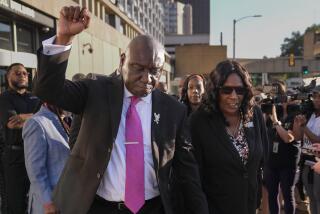Case Against Nichols Circumstantial, Based on Bad Science, Defense Says
- Share via
McALESTER, Okla. -- Closing arguments in the state murder trial of Terry L. Nichols wrapped up Tuesday, with defense lawyers contending that the case was largely circumstantial and based on bad science.
“They’re not searching for the truth,” lawyer Brian Hermanson said of the prosecution. “They’re trying to make a case.
“The state can’t just suggest things and expect you to take the leap,” he told the jury.
Nichols, 49, is charged with 161 counts of first-degree murder for his role in the 1995 bombing of Oklahoma City’s Alfred P. Murrah Federal Building, which killed 168 people. He is already serving a federal life sentence for the deaths of eight government agents. State prosecutors are seeking the death penalty against Nichols for the 160 others killed in the attack, as well as one victim’s fetus.
The jury is to begin deliberating today. If Nichols is found guilty, the trial will move into the penalty phase, where jurors will decide whether he should face the death penalty or life in prison.
Prosecutors have alleged that Nichols helped executed bomber Timothy J. McVeigh build the 4,000-pound ammonium nitrate and fuel bomb to avenge the federal raid on the Branch Davidian compound near Waco, Texas, in 1993.
But defense lawyers argued that Nichols -- who they say was at home in Kansas when the bomb exploded -- had been duped by McVeigh, who protected unnamed conspirators and set up Nichols to take the blame.
Fueling the conspiracy theory were numerous witness accounts of a man who did not resemble Nichols who was seen with McVeigh in the weeks before the bombing. “The state wants you to believe all the witnesses are deluded,” defense lawyer Barbara Bergman said Tuesday.
Hermanson said prosecutors looked at evidence in a vacuum, tailoring the facts to fit their case. “They drew one conclusion when there might be multiple conclusions,” he said. For example, prosecutors said that $20,000 in cash found hidden in Nichols’ home came from a gun dealer Nichols allegedly had robbed to raise money for the bomb. Hermanson said the cash could have come from the sale of Nichols’ house after a divorce.
A receipt for 2,000 pounds of ammonium-nitrate fertilizer found in Nichols’ home, which prosecutors said linked him to the bomb plot, could have another explanation, Hermanson said. McVeigh, who often visited Nichols, could have planted the receipt to implicate his friend. “If it’s going to be used for the biggest crime in the country, do you keep the receipt?” he asked. “Could it be that [Nichols] is innocent and McVeigh is the bad person?”
Bergman questioned the science behind government testimony linking a drill bit used in the burglary of a rock quarry to one found at Nichols’ home. Prosecutors said Nichols broke into the quarry to collect explosives used in the bomb. Bergman scoffed at the idea that “every drill bit causes marks to the exclusion of every other drill bit in the world.... Drill bit identification is not like ballistics. It’s not a science.”
During the two-month trial, no witnesses identified Nichols as the man who bought the fertilizer, stole explosives or robbed a gun collector. But in a lengthy rebuttal Tuesday, prosecutor Sandra Elliott said evidence linking Nichols to the bomb plot was too plentiful to discount.
“There is no question he knew what was going on. He was an active and willing participant at every critical stage of this conspiracy,” she said. “For you to believe he is not involved, you would have to believe there are so many coincidences falling down around Mr. Nichols that it’s unimaginable.”
More to Read
Sign up for Essential California
The most important California stories and recommendations in your inbox every morning.
You may occasionally receive promotional content from the Los Angeles Times.













